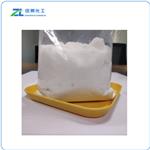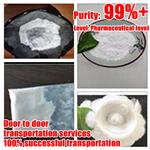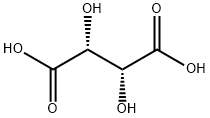L(+)-Tartaric acid
- CAS No.
- 87-69-4
- Chemical Name:
- L(+)-Tartaric acid
- Synonyms
- TARTARIC ACID;L-TARTARIC ACID;TARTRATE;(2R,3R)-2,3-DIHYDROXYSUCCINIC ACID;Tartaric;lev;2,3-Dihydroxysuccinic acid;l-tartaric;2,3-DIHYDROXYBUTANEDIOIC ACID;levo
- CBNumber:
- CB8212874
- Molecular Formula:
- C4H6O6
- Molecular Weight:
- 150.09
- MDL Number:
- MFCD00064207
- MOL File:
- 87-69-4.mol
- MSDS File:
- SDS
| Melting point | 170-172 °C(lit.) |
|---|---|
| alpha | 12 º (c=20, H2O) |
| Boiling point | 191.59°C (rough estimate) |
| Density | 1.76 |
| vapor density | 5.18 (vs air) |
| vapor pressure | <5 Pa (20 °C) |
| FEMA | 3044 | TARTARIC ACID (D-, L-, DL-, MESO-) |
| refractive index | 12.5 ° (C=5, H2O) |
| Flash point | 210 °C |
| storage temp. | Store at +5°C to +30°C. |
| solubility | H2O: soluble1M at 20°C, clear, colorless |
| form | Solid |
| pka | 2.98, 4.34(at 25℃) |
| color | White or colorless |
| PH | 3.18(1 mM solution);2.55(10 mM solution);2.01(100 mM solution); |
| Odor | at 100.00 %. odorless |
| Odor Type | odorless |
| optical activity | [α]20/D +13.5±0.5°, c = 10% in H2O |
| Water Solubility | 1390 g/L (20 ºC) |
| JECFA Number | 621 |
| Merck | 14,9070 |
| BRN | 1725147 |
| Dielectric constant | 35.9(-10℃) |
| Stability | Stable. Incompatible with oxidizing agents, bases, reducing agents. Combustible. |
| InChIKey | FEWJPZIEWOKRBE-JCYAYHJZSA-N |
| LogP | -1.43 |
| FDA 21 CFR | 184.1099; 582.1099; 582.6099 |
| Substances Added to Food (formerly EAFUS) | TARTARIC ACID, L |
| SCOGS (Select Committee on GRAS Substances) | L(+)-tartaric acid |
| CAS DataBase Reference | 87-69-4(CAS DataBase Reference) |
| FDA UNII | W4888I119H |
| NIST Chemistry Reference | Butanedioic acid, 2,3-dihydroxy- [r-(r*,r*)]-(87-69-4) |
| EPA Substance Registry System | Tartaric acid (87-69-4) |
SAFETY
Risk and Safety Statements
| Symbol(GHS) |  GHS05 |
|||||||||
|---|---|---|---|---|---|---|---|---|---|---|
| Signal word | Danger | |||||||||
| Hazard statements | H318 | |||||||||
| Precautionary statements | P280-P305+P351+P338 | |||||||||
| Hazard Codes | Xi | |||||||||
| Risk Statements | 36/37/38-41 | |||||||||
| Safety Statements | 26-36-37/39-36/37/39 | |||||||||
| WGK Germany | 3 | |||||||||
| RTECS | WW7875000 | |||||||||
| Autoignition Temperature | 797 °F | |||||||||
| Hazard Note | Irritant | |||||||||
| TSCA | Yes | |||||||||
| HS Code | 29181200 | |||||||||
| NFPA 704 |
|
L(+)-Tartaric acid price More Price(87)
| Manufacturer | Product number | Product description | CAS number | Packaging | Price | Updated | Buy |
|---|---|---|---|---|---|---|---|
| Sigma-Aldrich | T109 | L-(+)-Tartaric acid ≥99.5% | 87-69-4 | 500g | $53.5 | 2024-03-01 | Buy |
| Sigma-Aldrich | T109 | L-(+)-Tartaric acid ≥99.5% | 87-69-4 | 3kg | $242 | 2024-03-01 | Buy |
| Sigma-Aldrich | 8.18531 | (2R,3R)-(+)-Tartaric acid for resolution of racemates for synthesis | 87-69-4 | 100G | $37.4 | 2024-03-01 | Buy |
| Sigma-Aldrich | 8.18531 | (2R,3R)-(+)-Tartaric acid for resolution of racemates for synthesis | 87-69-4 | 500G | $82.2 | 2024-03-01 | Buy |
| Sigma-Aldrich | 8.18531 | (2R,3R)-(+)-Tartaric acid for resolution of racemates for synthesis | 87-69-4 | 2.5KG | $247 | 2024-03-01 | Buy |
L(+)-Tartaric acid Chemical Properties,Uses,Production
Chemical Properties
Tartaric acid occurs as colorless monoclinic crystals, or a white or almost white crystalline powder. It is odorless, with an extremely tart taste. L-(+)-Tartaric Acid is a naturally occurring chemical compound found in berries, grapes and various wines. It provides antioxidant properties and contributes to the sour taste within these products.
Uses
In the soft drink industry, confectionery products, bakery products, gelatin desserts, as an acidulant. In photography, tanning, ceramics, manufacture of tartrates. The common commercial esters are the diethyl and dibutyl derivatives used for lacquers and in textile printing. Pharmaceutic aid (buffering agent).
Uses
L-(+)-Tartaric acid is widely utilized in pharmaceutical industries. It is used in soft drinks, confectionaries, food products, gelatin desserts and as a buffering agent. It forms a compound, TiCl2(O-i-Pr)2 with Diels-Alder catalyst and acta as a chelate agent in metal industries. Owing to its efficient chelating property towards metal ions, it is used in farming and metal industries for complexing micronutrients and for cleaning metal surfaces, respectively.
Production Methods
Tartaric acid occurs naturally in many fruits as the free acid or in
combination with calcium, magnesium, and potassium.
Commercially, L-(+)-tartaric acid is manufactured from potassium
tartrate (cream of tartar), a by-product of wine making.
Potassium tartrate is treated with hydrochloric acid, followed by the
addition of a calcium salt to produce insoluble calcium tartrate.
This precipitate is then removed by filtration and reacted with 70%
sulfuric acid to yield tartaric acid and calcium sulfate.
Definition
ChEBI: L-tartaric acid is a tetraric acid that is butanedioic acid substituted by hydroxy groups at positions 2 and 3. It is a conjugate acid of a L-tartrate(1-). It is an enantiomer of a D-tartaric acid.
General Description
Tartaric Acid belongs to the group of carboxylic acids, and is abundantly found in grapes and wine. It is widely used in drugs, food, and beverage industry.
Flammability and Explosibility
Not classified
Pharmaceutical Applications
Tartaric acid is used in beverages, confectionery, food products, and
pharmaceutical formulations as an acidulant. It may also be used as
a sequestering agent and as an antioxidant synergist. In pharmaceutical
formulations, it is widely used in combination with
bicarbonates, as the acid component of effervescent granules,
powders, and tablets.
Tartaric acid is also used to form molecular compounds (salts
and cocrystals) with active pharmaceutical ingredients to improve
physicochemical properties such as dissolution rate and solubility.
Biochem/physiol Actions
L-(+)-Tartaric acid serves as a donor ligand for biological processes. It is used as a food additive in candies and soft drinks to impart a sour taste.
Safety Profile
Moderately toxic by intravenous route. Mildly toxic by ingestion. Reaction with silver produces the unstable silver tartrate. When heated to decomposition it emits acrid smoke and irritating fumes.
Safety
Tartaric acid is widely used in food products and oral, topical, and
parenteral pharmaceutical formulations. It is generally regarded as
a nontoxic and nonirritant material; however, strong tartaric acid
solutions are mildly irritant and if ingested undiluted may cause
gastroenteritis.
An acceptable daily intake for L-(+)-tartaric acid has not been set
by the WHO, although an acceptable daily intake of up to 30 mg/kg
body-weight for monosodium L-(+)-tartrate has been established.
LD50 (mouse, IV): 0.49 g/kg
storage
The bulk material is stable and should be stored in a well-closed container in a cool, dry place.
Incompatibilities
Tartaric acid is incompatible with silver and reacts with metal carbonates and bicarbonates (a property exploited in effervescent preparations).
Regulatory Status
GRAS listed. Accepted for use as a food additive in Europe. Included in the FDA Inactive Ingredients Database (IM and IV injections; oral solutions, syrups and tablets; sublingual tablets; topical films; rectal and vaginal preparations). Included in nonparenteral medicines licensed in the UK. Included in the Canadian List of Acceptable Non-medicinal Ingredients.
L(+)-Tartaric acid Preparation Products And Raw materials
Raw materials
Preparation Products
1of5
| Supplier | Tel | Country | ProdList | Advantage | |
|---|---|---|---|---|---|
| Jinan Finer Chemical Co., Ltd | +86-531-88989536 +86-15508631887 | sales@finerchem.com | China | 2967 | 58 |
| Hefei TNJ Chemical Industry Co.,Ltd. | +86-0551-65418679 +86-18949832763 | info@tnjchem.com | China | 2989 | 55 |
| Xiamen AmoyChem Co., Ltd | +86-592-6051114 +8618959220845 | sales@amoychem.com | China | 6387 | 58 |
| Hebei Dangtong Import and export Co LTD | +8615632927689 | admin@hbdangtong.com | China | 991 | 58 |
| Wuhan Quanjinci New Material Co.,Ltd. | +8615271838296 | kyra@quanjinci.com | China | 1532 | 58 |
| Wuhan Ruichi Technology Co., Ltd | +8613545065237 | admin@whrchem.com | China | 164 | 58 |
| Hebei Mojin Biotechnology Co., Ltd | +8613288715578 | sales@hbmojin.com | China | 12453 | 58 |
| Dorne Chemical Technology co. LTD | +86-13583358881 +86-18560316533 | Ethan@dornechem.com | China | 294 | 58 |
| Shandong Huisheng Import & Export Co., Ltd. | +86-13176845580 +86-13176845580 | da@zhongda-biotech.com | China | 248 | 58 |
| Anhui Zhongda Biotechnology Co., Ltd | +8619956560829 | justine@zhongda-biotech.com | China | 300 | 58 |
Related articles
- Biosynthesis of L(+)-tartaric acid
- L(+)-Tartaric acid (TA) is the primary nonfermentable soluble acid in grapes and the principal acid in wine, contributing impo....
- Jun 2,2022
View Lastest Price from L(+)-Tartaric acid manufacturers
| Image | Update time | Product | Price | Min. Order | Purity | Supply Ability | Manufacturer | |
|---|---|---|---|---|---|---|---|---|
 |
2024-04-23 | L(+)-Tartaric acid
87-69-4
|
US $200.00-85.00 / kg | 1kg | 99% | 20ton | Hebei Zhuanglai Chemical Trading Co.,Ltd | |
 |
2024-04-23 | L(+)-Tartaric acid
87-69-4
|
US $1.00 / g | 1g | 99% | 1000kg | Dorne Chemical Technology co. LTD | |
 |
2024-04-23 | L(+)-Tartaric acid
87-69-4
|
US $0.00 / Kg/Drum | 1KG | 99% | 200mt | Jinan Finer Chemical Co., Ltd |
-

- L(+)-Tartaric acid
87-69-4
- US $200.00-85.00 / kg
- 99%
- Hebei Zhuanglai Chemical Trading Co.,Ltd
-

- L(+)-Tartaric acid
87-69-4
- US $1.00 / g
- 99%
- Dorne Chemical Technology co. LTD
-

- L(+)-Tartaric acid
87-69-4
- US $0.00 / Kg/Drum
- 99%
- Jinan Finer Chemical Co., Ltd
87-69-4(L(+)-Tartaric acid)Related Search:
1of4





